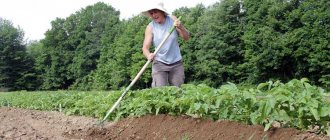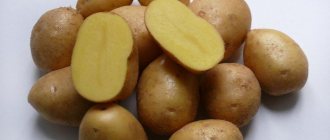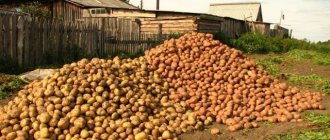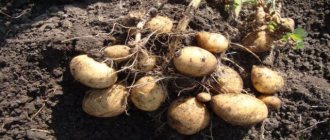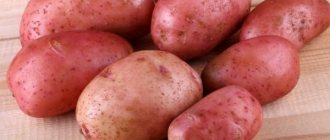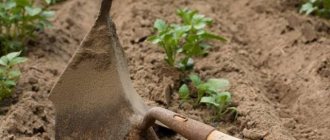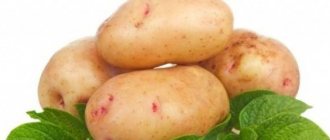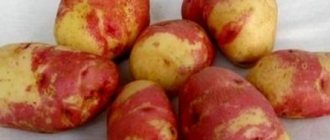Diseases and pests of the variety
The Colette variety has good resistance to popular potato diseases such as cancer or golden nematode.
Damage by late blight is possible, but due to the early ripening of the crop, this is a relatively rare occurrence. To prevent the disease, you can treat the planting material with special chemical compounds: the drug “Cruiser”, “Force” or a mixture of “Prestige” and “Maxima”. Pests will be much more dangerous for potatoes, among which the Colorado potato beetle and wireworm are the most common. In the first case, leaves and shoots suffer, and in the second, the main blow of the pest falls on the tubers in which it forms tunnels. In the fight against the Colorado potato beetle, the most effective method will be the manual removal of larvae and adults from bushes, as well as the use of the preparations “Prestige” and “Batsikol” (diluted with water in accordance with the instructions).
Getting rid of wireworms is somewhat more difficult, so either you will take care of the safety of the tubers in advance and treat the planting material with preventive compounds, or you will have to place traps from plant debris on the site, but it is not a fact that in this way it will be possible to remove all pests from the territory.
Advantages, disadvantages and taste
Potatoes of the Colette variety have the following advantages:
- High level of rooting and good germination;
- Friendly return of an early high-quality potato harvest;
- Excellent keeping quality of root crops;
- Transportability;
- Resistant to mechanical stress;
- Good taste;
- Nematode resistance;
- Commercial appearance of tubers.
Minor disadvantages include the dependence of the amount of future harvest on the type of soil. Potato "Colette" is a heat-loving variety that requires irrigation and regular thinning.
The table shows data on the growing season of different potato varieties:
| Name | Variety | Days |
| Nikulinsky | Late ripening | 115-120 |
| Cardinal | Late ripening | 110-120 |
| Rocco | Late ripening | 100-115 |
| Kiwi | Late ripening | 120-130 |
| Ivan da Marya | Late ripening | 115-130 |
| Slav | Late ripening | From 125 to 140 |
| Borovichok | Early ripening | 70-90 |
| Elmundo | Early ripening | 70-80 |
| Felox | Early ripening | From 65 to 70 |
| Bellarosa | Early ripening | From 50 to 70 |
| Natasha | Early ripening | From 70 to 80 |
| Karatop | Extra early | From 60 to 65 |
| Riviera | Extra early | From 40 to 80 |
| Zhukovsky early | Extra early | 60 to 70 |
| Farmer | Extra early | From 50 to 60 |
| Minerva | Extra early | 45-50 |
| Crane | Mid-late | From 100 to 120 |
| Sorcerer | Mid-late | 80-90 |
| Mozart | Mid-late | From 100 to 180 |
| Ramona | Mid-late | From 80 to 100 |
| Limonka or Picasso | Mid-late | 120-130 |
| Yanka | Mid-early | 90-100 |
| Giant | Mid-early | From 80 to 100 |
| Tuscany | Mid-early | 70-90 |
| Purple Haze | Mid-early | 90-100 |
| Openwork | Mid-early | 75-85 |
Features of growing Colette
Everyone knows that Colleta is a potato variety that can be grown twice per season. Moreover, its yield will be high if properly prepared for planting. The vegetable is planted in the ground, depending on the region. In the south it is typical to start planting at the end of April, but in the north of the country the season begins in the middle and lasts until the end of May.
To get a good harvest, you need to analyze soil moisture and temperature
The absence of frosts is also important, since they greatly affect potato yields.
Preparing for landing
To get a high yield, instructions for proper planting and care must be followed. It is recommended to germinate Colleta potatoes before planting them in the ground. Thus, the time for the development of the bush in open ground will be reduced.
Germination is done as follows:
- seed potatoes are carefully sorted, only healthy tubers are selected;
- for germination, it is best to use boxes where the seed tubers are placed and sprinkled with humus;
- potatoes are laid in layers, between which compost or humus is poured and Gumi is watered;
- the top layer is also covered with compost;
- then the boxes are wrapped in film and placed in a dark, warm place for germination.
Sprouted potatoes are planted in the ground
Advice. When planting potatoes in the ground, it is better to place them sprouts down. This will result in a large spreading bush that will bring a good harvest.
Landing
Potatoes are planted in holes located at a distance of 25 centimeters, into which ash and humus are placed. The distance between rows should be at least 75 centimeters. During the process of potato growth, it is necessary to do weeding and hilling. When the potatoes are ripe, you need to cut off the tops before digging them up.
Loosening
This process must be carried out in order to ensure air flow to the roots of the potato bush and the removal of weeds. The first time the soil is loosened after the first shoots appear. The hoe should not go deeper than one and a half centimeters in depth. During the growth process, loosening can be carried out in parallel with hilling.
Hilling
To get a good harvest, this process must be done several times.
The first hilling should be carried out immediately after germination. In this case, the potatoes can be covered with soil.
This way, the sprouts will not freeze at night, when the air temperature is still significantly lower. Before the first flowering, it is recommended to “burn” the potatoes two more times.
Watering
It is done if the summer is hot and it rains very rarely. Soil moisture is very important for potatoes, but you need to have a sense of proportion and not over-wet the soil.
Top dressing
For feeding, mineral fertilizers such as Nitrophoska are used. Fertilizer is applied for the first time when it becomes noticeable that the potato bushes are weak, the stems are thin, and the leaves have lost their color saturation. Subsequent application of fertilizers is carried out every ten days.
The first shoots of Colette potatoes
Harvesting
The timing of potato harvesting varies depending on the growing region. After 1.5 months it can be eaten. Remove for storage when the tops are dry. When signs of late blight appear before harvesting, it is better to trim the stems so that the tubers do not get sick.
Harvest potatoes in dry weather, preferably by hand. The potato skin is very thin, try not to damage it. Let it dry well and lie in the sun.
The seeds are greened before being stored in the cellar. Sort the tubers by size, quality and storage. The room temperature should be no higher than +3◦, air humidity 80%. How to properly store potatoes can be found here.
Harvest and storage
With proper care, the first potato harvest is harvested at the end of June - mid-July, depending on the region. The signal to start harvesting is the drying tops. They dig up bushes by hand or using special equipment.
Attention! When harvesting, it is important not to damage the thin skin of the tubers. Tubers with mechanical damage are poorly stored, lose their presentation, and sometimes even their taste.
After harvesting, the soil is weeded, cultivated and watered. Then they begin planting again. Care measures are the same as when growing the first crop. The potatoes are dug up for the second time around September.
The tubers are harvested in clear, dry weather and left on a flat surface to dry for several days. The harvest is sorted, removing damaged and diseased tubers. Healthy potatoes weighing 50-80 g are selected for planting. After this, all the remaining potatoes are lowered into the basement for storage.
Storage features and keeping quality of the variety
Potatoes of the Colette variety are stored well for a year after harvesting and are not damaged during transportation. Keeping quality is 92%. The tendency to germinate is low. The storage room should be well ventilated and have a temperature of about +3°C.
Potato care
Caring for the beds is simple and consists of:
- weeding;
- loosening;
- watering;
- protection from pests.
Watering must be done at least once a week in dry weather. If it rains once or twice a week, then the field does not need to be watered.
Weeding is carried out during the entire growth of the fruit, otherwise the field will be overgrown with grass and the tubers will not grow. In this case, the plants are hilled up so that the tubers do not appear above the ground when ripe. You should know that in hardened soil, vegetables do not develop well, and nutrients go to weeds, not providing nutrition to the planted plants.
There are many chemical products sold on the market to protect potatoes from the Colorado potato beetle. Also, some gardeners use an old method that is safe for plants: collecting beetles by hand. In this case, you need to lift the leaves and tear off those on which yellow insect eggs are laid. If the field is treated with chemicals, the final treatment should be carried out no later than two weeks before harvest, otherwise the tubers will be contaminated.
Step-by-step instructions for growing
Inventory
The Colette variety is suitable both for growing on large plots using all means of mechanization, and for personal plots. If it is grown in fields, you need to use:
- Plows and cultivators.
- Harrows or diskers.
- Potato planters.
- Sprayers or sprinklers.
- Harvesters.
If the variety is grown in a household, the inventory can be reduced to:
- shovel;
- rake;
- watering can;
- bucket.
Preparation of soil and planting material
Soils
The site is prepared in the fall, when both organic matter (manure, droppings, humus, peat, etc.) and mineral fertilizers are applied to it in the dosage established by the manufacturer.
Advice
In the spring, the area is harrowed, disced, or at least dug up and leveled with a rake with a sharp edge to grind up lumps of soil. If possible, 400-500 g of wood ash is added to each tuber.
Planting material
Seeds are prepared in the fall. Those tubers are selected that:
- Weigh at least 80 g.
- They have no mechanical damage or signs of pest exposure.
About a month before planting, the potatoes are warmed up in a bright and warm (at least +14 degrees) room. Tubers that do not germinate are discarded and not used for planting.
Before planting, tubers are treated with complex preparations (Prestige, Heteroauxin, etc.) or old fungicides (potassium permanganate solution, copper sulfate, Bordeaux mixture, etc.).
Time selection depending on region
Potatoes are planted when the soil warms up to +7-8 degrees at a depth of 10 cm. Climatically, this usually corresponds to the appearance of leaves on a birch tree. But in general the timing looks like this:
- Central region – early May.
- Central Chernozem and Volga-Vyatka - the first ten days of May.
- North Caucasus - early April.
Planting scheme
Colette potatoes are planted like this:
- Row spacing is at least 65-75 cm.
- Between bushes - at least 30-35 cm.
- Planting depth is about 8 cm.
Care
Hilling
Hilling is carried out when the bushes reach 10-12 cm in height. Previously, hilling was possible only when there was a threat of return frosts. Then hilling is carried out 2-3 times during the growing season.
Watering
The Colette variety needs at least 2-3 waterings per season. Irrigation by sprinkling (using anything from an industrial sprayer to a hose with a sprinkler) is carried out at sunrise or sunset so that direct rays of the sun do not fall on the site. With drip irrigation, the timing of watering is not important.
Loosening
The soil should be loosened as often as possible. Ideally, the first loosening is carried out 3-4 days after planting, and then every 10-12 days.
Top dressing
Ideally, the Colette variety does not need feeding. But if possible, it can be fed with a solution of the following composition:
- 20 g wood ash.
- 30 g potassium sulfate.
- 15 liters of warm water.
The solution is poured in an amount of 1 liter under the bush.
Attention!
A month before ripening, feeding should be stopped.
Possible diseases and how to deal with them
Colette potatoes are highly resistant to diseases and pests, but if care rules are not followed, this can lead to a number of negative consequences. Due to increased humidity, potatoes can develop late blight - a dangerous fungal disease that can lead to the death of potatoes. When the first signs are detected, the plants should be treated with fungicides. Pests such as wireworms, Colorado potato beetles, and potato moths are also dangerous for potatoes. Which have a very detrimental effect on the growth of the crop, and as a result on its productivity. If pests are detected, the plants must be treated as soon as possible with special chemicals. Remember that it is better to prevent disease and treat seed material with specialized preparations before planting than to fight diseases and pests - which does not always end well.
Reviews about the variety
Colette potatoes are quite often grown using the seedling method and using seed material from the company, as well as from Tula. “Colette,” according to reviews from vegetable growers, is characterized as one of the types of unpretentious varieties of early-harvest potatoes with a long shelf life and resistance to major diseases.
Potato tubers are large, they are located quite closely in the bush, and digging is a pleasure. The minimum percentage of starchiness, which for this variety does not exceed 15%, does not allow the potato pulp to boil too much. And regular and abundant watering, to which this variety is very susceptible, is accompanied by consistently high and good yields.
Advantages and disadvantages
In addition to rapid ripening and the presence of large tubers, the Zhukovsky variety has other advantages:
- transportability;
- excellent keeping quality;
- ease of care;
- resistance to diseases.
Potatoes Zhukovsky early
Tubers are practically not affected by potato cancer, nematode, rhizoctonia and scab; resistance to viral diseases is average.
Potato silver scab
This potato tolerates drought and heat well, although the tubers form a little smaller. This variety is perfect for growing for sale, since it is one of the first to produce a harvest, and there is still little competition in the market. In addition, the tubers are not afraid of mechanical damage and retain their presentation for a long time, which is why they are in demand among buyers. If the weather is favorable, already 60 days after germination you can get up to 12 tons of high-quality tubers per hectare, and at the end of the growing season this figure increases to 45 tons. And even in bad weather conditions, the yield of Zhukovsky is about 200-270 kg per hundred square meters.
High yield of potatoes Zhukovsky
For this potato to sprout, 5-7 degrees of heat is enough. If necessary, it can be planted in the soil directly from the cellar, without pre-heating and germination of tubers. Since planting is done early and the soil is still saturated with moisture, tubers have time to form before the onset of summer drought. Water the bushes only as a last resort, for example, if there has been no rain for more than a month and the potatoes are already about to bloom.
The variety has very few disadvantages. The most serious of them is low resistance to late blight. In rainy summers, bushes are easily affected by late blight, especially when planting thickly, and this does not have the best effect on the marketability and yield of tubers. Therefore, when purchasing “Zhukovsky” for planting, be sure to stock up on preparations for the protective treatment of tops.
Late blight of potatoes
Another disadvantage is the deterioration of taste when there is a delay in harvesting potatoes. Tubers that have been over-exposed in the ground are no longer as crispy when fried, and less tasty when boiled. But this is rather a problem with all early varieties, and not just “Zhukovsky”.
Potato variety Gala: ripening time and characteristics
There are many varieties of potatoes that differ in ripening time, taste and yield. Not every novice gardener knows about Gala potatoes
Its advantages should be taken into account. This is an unpretentious, high-yielding variety, which, in addition to all of the above, is also resistant to many diseases.
Advantages and disadvantages of Gala potatoes
There are many positive aspects to growing this variety. But there are also disadvantages that you need to familiarize yourself with before deciding to plant Gala on your site.
Advantages of the Gala variety:
- suitable for any region of our country;
- potato bushes are undemanding in care;
- unpretentious to the soil;
- is resistant to many diseases;
- has a short ripening period;
- characterized by high productivity;
- good taste;
- possibility of long-term storage.
One of the disadvantages is the fact that if the harvest is not harvested on time, the beneficial substances in root crops are significantly reduced. In addition, the Gala variety is susceptible to diseases such as late blight.
Information about the variety and main characteristics
This is a popular early potato variety that produces the first harvest after 2 months. Developed by experienced specialists from the German company Norika. Potato Gala made its presence known in our markets 11 years ago. Is a sales leader.
Tubers and yield
Productivity is high. Ripening time is 65-70 days. When harvesting, you can collect about 20 tubers from each bush. Potatoes are small in size, weighing up to 120 g. The shape is round, sometimes oval. The color of the tubers is light and uniform. Length 8-9 cm, width 5-6 cm.
Expert opinion
Stanislav Pavlovich
Gardener with 17 years of experience and our expert
Reference! From a plot of 1 hectare you can harvest up to 30 tons of potatoes.
The nutritional value
These are table potatoes. The pulp is rich in color, light yellow. The color does not change during cooking.
The nutritional value:
- starch – 13-15%;
- vitamin C – 22%;
- proteins – 1.7%;
- sugar – 0.31%.
There is little starch, more carotene. This allows Gal to supplement the diet of people who are eating healthy.
Immunity to diseases
Gala potatoes are resistant to various diseases. However, there are ailments that bushes cannot resist. Immunity to many pathogenic organisms makes the Gala variety competitive.
Favorable regions for planting
Gala potatoes are suitable for cultivation in most regions of our country. The plant adapts well to most soil types and weather conditions.
The variety is grown in the following regions:
- Novgorod;
- Yaroslavsky;
- Kostroma;
- Tversky;
- Kaliningradsky;
- Vologda;
- Pskovsky.
The variety is also popular in Belarus and Ukraine.
Soil and seed preparation
The area is treated before planting potatoes. They dig him up; remove debris, plant roots, and stones. Lucky are those gardeners whose soil is light (chernozems, alumina). In autumn, the soil is fed in advance with any type of organic matter (humus, compost).
The preparation of tubers consists of the following stages of work:
- The seeds are sorted, sorted into small and large.
- They are treated with a growth activator, which is aimed at reducing the development of pathogenic microorganisms.
- The tubers are left for a while until they germinate.
Expert opinion
Stanislav Pavlovich
Gardener with 17 years of experience and our expert
Reference! The best potatoes for planting are those with strong shoots and dense, slightly green skin.
Timing, methods and planting schemes
To understand when to plant Gala potatoes, you need to wait until the soil warms up to 10-11C°. Lower temperatures will lead to rotting of the seed material. There are two options for planting this variety. This is planting in a hole and in a row.
Next you need to mark the beds, which is suitable for two cases:
- leave 55-60 cm between rows;
- the distance between the holes is at least 30 cm;
- the depth of each pit (hole) is 14-15 cm;
- if the soil is poor, spread organic fertilizer at the bottom of the holes;
- Place one potato in the center of the hole or hole and sprinkle with soil.
There is no need to plant several potatoes in one hole. This will result in small root crops. Gala is planted from mid-March to mid-May. It all depends on weather conditions and the region of the country.
Watering
The variety does not tolerate waterlogging, so watering should be uniform. After planting is completed, it is recommended to add 1.5-2 liters of water under each bush.
Double harvest and storage
The characteristics of the variety allow us to count on two harvests. There are two ways to achieve this:
- Harvest the first potato harvest in July and replant some of the tubers. It is advisable to carry out a second planting in the greenhouse.
- After the early potatoes ripen, harvest. To do this, you need to dig up the bushes entirely, collect the tubers from them and bring the freed plants back into the ground. It is worth noting that immediately after replanting, the plants become sick, but over time they recover and are able to produce a new harvest.
The first harvest of Colette potatoes usually ripens in July. It is necessary to prepare for harvesting: stop watering, fertilizing and treating with drugs 3 weeks in advance, cut the tops to a level of 15 cm 2 weeks in advance. This will allow the potatoes to ripen faster and their skins to get stronger.
Harvesting can be done mechanically.
Note! You need to dig up potatoes in sunny weather. Then spread under the canopy and dry.. https://www.youtube.com/embed/tfwR0TuzqmE
After this, the crop must be sorted out: remove damaged tubers, select small healthy potatoes weighing 60-70 grams for planting material. Then the potatoes can be stored in the basement. The variety can be stored throughout the winter. To do this, the following storage conditions must be met:
- the basement temperature must be constant;
- ideal storage temperature is 3 degrees;
- the basement should be well ventilated.
Review Reviews
This variety has been grown in Russia since 2002, so it has already received numerous reviews from amateur gardeners and agricultural professionals. Let's look at some of them:
Grigory Vladimirovich writes: “A neighbor described potatoes of the Colette variety and offered half a bag of achenes of the variety for growing. I planted them, the tubers grew beautiful, even, the potatoes are delicious when boiled and fried, and have a sweetish taste. Doesn't boil over. It grew in a garden bed, I never watered it in the summer, you just need to break up the grass so as not to choke the plants and kill the beetles. This variety does not require any more care. The harvest was good; half a bag of seeds yielded 5 bags of vegetables. Next year I will plant this variety again.”
Characteristic
The shape of Caprice tubers is round-convex, oval, almost regular in shape. Dimensions - average, weight - from 90 to 120 g.
The peel is smooth and yellow. The eyes are small, in small numbers, not very deep. The pulp has a high content of dry matter and is dark yellow in color.
Starch content - 13% - 17% - average level. Starch will accumulate more during the sunny, warm summer season; fertilizers also affect the starch content in root crops.
You can compare the starch content in different varieties of potatoes using the table below:
| Variety name | Starch content |
| Caprice | 13-17% |
| Farmer | 9-12% |
| Minerva | 15-18% |
| Rogneda | 13-18% |
| Lasunok | 15-22% |
| Rowanushka | 11-18% |
| Lady Claire | 12-16%% |
| Bellarosa | 12-16% |
| Veneta | 13-15% |
| Lorch | 15-20% |
| Margarita | 14-17% |
The bush is stemmed, erect or semi-erect, medium in height. The leaves are typical potato in shape, small in size, grow at intervals, dark green in color, wrinkled structure, without pubescence.
The inflorescences consist of several small or medium-sized flowers, the corolla is white.
Climatic growing zones
“Caprice” is very popular in European countries; in the Russian Federation it grows best in the Central region. It has an average degree of early maturity and manages to develop in the northern regions of the country. In the southern regions it tolerates drought.
It is possible to grow throughout the Russian Federation and nearby countries.
Productivity
The productivity is quite high; under favorable conditions and proper care, a harvest of more than 5.8 tons per hectare can be achieved. The average yield is about 400 centners per 1 ha, which exceeds the established standards. Commercial yield is up to 350 centners per hectare.
And in the table below you will see what the yield indicators are for other varieties:
| Variety name | Productivity (c/ha) |
| Caprice | 200-400 |
| Aladdin | 450-500 |
| Beauty | 400-450 |
| Grenada | 600 |
| Vector | 670 |
| Sifra | 180-400 |
| League | 210-350 |
| Elmundo | 250-345 |
| Cast iron | 100-200 |
| Sheri | 170-370 |
| Bryansk delicacy | 160-300 |
Application
“Caprise” is a table variety, most often used as food, it does not overcook due to its low starch content. Suitable for dishes that require whole potatoes, soups, frying, boiling, French fries.
Yellow potatoes do not boil soft; it is better to choose white varieties for mashed potatoes. You can eat healthy root vegetables - hard, dense, without sprouting or greening.
Potatoes that have turned green (laid in the sun for some time) contain toxic substances; consuming them can harm the body. In the production of starch, alcohol components, cosmetic masks, and other preparations, root vegetables, peels, and tops are used.
Potato juice is used in medicine - for the prevention of cardiovascular diseases, against burns, relieves inflammation, but in large quantities it can increase the temperature.
Taste qualities
The variety, according to the testing commission, has good taste - moderately sweet and aromatic. You can taste the full real taste of potatoes only by boiling them in their skins; all the beneficial microelements will be preserved.
IMPORTANT! The taste may also change due to the application of fertilizers, try to choose organic materials for fertilizing. A large amount of nitrogen in the soil and a lack of potassium will spoil the taste.
History of the name. Characteristics, description of potatoes
Potatoes were popularly called lemon for the bright lemon-yellow color of the peel and pulp and the round shape reminiscent of this fruit. But there is no specific variety with such an official name. In the south of Russia, Vineta potatoes are considered Limonka; in the middle zone, Colette seed potatoes are sold under this name. Both of these varieties were bred in Germany and are considered one of the best for making chips there. Their properties are similar enough to have a common name.
Two varieties of potatoes united by one name Limonka
The Vineta potato variety was created 25 years ago based on the genetic code of the famous yellow-fruited Adretta and repeats many of the properties of its predecessor. Distributed in arid regions.
The Colette variety is a later variety, included in the state register in 2007, in many respects it is similar to Vineta, but is more demanding of moisture, and is grown in areas with cool and rainy summers.
Description of varieties Vineta and Colette (Limonka) - table
| Properties | Veneta - mid-early table variety | Colette - an early table variety |
| Bush | Spreading | Erect |
| Peel | Yellow. Rough, with a fine mesh. | Yellow, smooth. |
| Flesh color | Yellow, does not change after heat treatment. | Yellow, does not change after heat treatment. |
| Taste | Good. Tasting score 4.3 points. When frying, the slices do not crumble. When cooked, the friability of the tuber is average. | Good. Tasting score 4.5 points. When frying, the slices do not crumble. When cooked, the friability of the tuber is average. |
| Starch content | 12 – 15% | 12,2–15,2% |
| Tuber shape | Oval, rounded. | Oval, round, elongated. |
| Tuber weight | 60 – 95 g | 65 – 130 g |
| Eye depth | Surface 0.2 – 0.5 mm | Small, superficial 0.1 – 0.2 mm. |
| Flower coloring | The flowers are white. | The flowers are white. |
| Precocity | 40 -45 days from germination to the ripening of the first tubers, 70 - 75 days before harvest. | 45 days from germination to the ripening of the first tubers, 70 days before harvest. |
| Yield per bush | 10 – 12 tubers | 8 – 10 tubers |
| Drought resistance | Tall, grown mainly in arid regions with hot summers. | Requires sufficient humidity level. |
| Keeping quality | The tubers are resistant to damage, the safety of the tubers is 90%, which distinguishes this variety from other early varieties. | The tubers are resistant to damage, the preservation of tubers is 92%, which distinguishes this variety from other early ones. |
| Disease resistance | Resistant to all viruses and bacterial diseases of potatoes, except late blight. | Resistant to all viruses and bacterial diseases of potatoes, except late blight. |
| Pest resistance | Resistant to potato golden nematode. | Resistant to potato golden nematode. |
When comparing the properties, the reason for the appearance of the name Limonka in two different varieties becomes clear. They really are similar. All the distinctive features of these two varieties can be considered advantages. There are practically no disadvantages.
Colette's tubers are smooth, bright yellow, like lemons
Description and characteristics
The early ripening variety Colette forms tubers 2 months after planting. If you plant potatoes in April, then at the beginning of June you can try the earliest harvest. But for the middle zone such early planting dates are not suitable and the first tubers are ready for consumption only at the end of July - beginning of August.
Appearance of the bush
The erect, slightly spreading Kaleta bush is small in size. Lush green leaves with wavy edges form a fluffy bush. It is decorated with purple flowers, usually medium to large.
The formation of tubers occurs almost simultaneously: they are smooth, leveled, up to 10-12 pieces in a nest. Small tubers are extremely rare. The yellow peel and light yellow pulp are a distinctive feature of the variety, as can be seen in the photo.
Productivity of the variety
The weight of each tuber ranges from 60 to 125 g. With proper agricultural technology, Colette's yield approaches 250 c/ha. The first wave of harvesting yields from one hundred to 110-150 kg, and after 10 days the yield is already 160-280 kg.
Taste properties of root vegetables
Tubers of the Colette variety are characterized by the following features:
- oval shape;
- flat surface without deepening of the eyes;
- identical color of peel and pulp;
- low amount of starch (12-15%).
The tubers have 85-95% commercial qualities. Root crops have good shelf life: 90% of the crop is stored during the winter. Colette belongs to the table-type and universal-purpose varieties.
On a note! Due to their low starch content, tubers are used to prepare a variety of dishes. Heat treatment perfectly preserves the taste and shape of the tuber, which does not become overcooked.
Description of the variety
Colette has fast germination, high yield, excellent keeping quality, good marketability and taste. Easy to care for, resistant to pests and diseases, versatile in cooking.
The Colette table potato variety was developed by German breeders in the late 90s. It is mainly grown for the production of chips and French fries.
Other distinctive features of the Colette variety:
- amicable maturation;
- long-term storage;
- transportability;
- low susceptibility to nematodes.
Chemical composition, vitamins and microelements
Colette contains a large amount of vitamins, microelements and amino acids. It is beneficial for bone structure, digestive system and metabolism. This potato variety contains folic acid, which prevents the formation of cancer cells, as well as potassium and vitamins C and B6, which are beneficial for the cardiovascular system.
Attention! Due to their high potassium content, potatoes are contraindicated for people with kidney disease.
The flavonoid quercetin contained in the composition protects cells from free radicals. Colette potatoes improve skin condition and promote the disappearance of wrinkles.
Characteristics of Colette potatoes, yield
The tubers of the Colette variety are approximately the same size and have an oval, elongated shape. The weight of one potato is on average 130 g, the color of the pulp is pale yellow. The starch content is below normal - only 12-18%. The peel is smooth, bright yellow, the eyes are faint.
From 6 to 11 tubers are collected from one bush. The advantage is that they are located in a cluster and close to the surface, which simplifies digging. The average yield is 166-217 c/ha. The maximum yield was noted in the Rostov region - 290 c/ha.
Some sources claim that with proper agricultural technology, you can harvest up to 600 c/ha. At the same time, the high marketability of tubers is maintained - 76-98%.
Growing regions and planting dates
Despite the fact that the Colette variety was included in the State Register of Russia for cultivation in the Central, Volga-Vyatka and North Caucasus regions, it is grown almost everywhere in our country, as well as in Moldova and Ukraine. It grows well in regions with cool, humid summers.
In the south of the country, Colette is planted in late April - early May, in the central and northern regions - from mid to late May. By the time of planting, the soil should be sufficiently moistened and warmed up. The threat of frost should be completely past. Planting too early or late reduces yields.
Landing dates and rules
The timing of planting Colette potatoes varies significantly across regions.
When choosing the time for this agrotechnical activity, it is important to remember that not only very early, but also too late planting of seed material can lead to a significant decrease in yield. In any case, regardless of the climatic zone, the planting period for the Colette variety of potatoes is determined by both temperature and soil moisture indicators
- Seed potatoes "Colette" comply with GOST R 53136-2008. According to the originator, it is recommended to warm up the seed material, as well as germinate the tubers before planting.
- Potatoes of this variety are most often planted in rows with a row spacing of 0.75 m, and between neighboring plants in each row - 28-30 cm.
- Primary treatment of Colette seed potatoes is considered as a growth-stimulating measure, as well as an event aimed at protecting planting material from most diseases. For this purpose, it is allowed to use copper sulfate, potassium permanganate, wood ash and spraying tubers with “Prestige”, a combination of “Prestige” with “Maxim”, as well as with the preparations “Cruiser”, “Force”, “.
- Tilling the soil in the area allocated for planting, along with processing the planting material itself in the form of potato tubers, may also include nutrient spraying. Positive results when growing potatoes of the Colette variety are achieved by using nutrient solutions such as Nitrophoska and Mortar. Treatment of seed material with this composition should be carried out three times with an interval of ten days.
How to plant correctly
Germination. Three weeks before planting, seed potatoes are brought into a warm room, the temperature in which should be about +20 °C and humidity 80%. After a few days, the temperature is reduced to +10 °C, this helps the formation of strong shoots.
Tuber processing. This event is carried out in order to protect the seed material from insect pests and some diseases. The following preparations are used to process tubers: “Prestige”, “Maxim”, “Cruiser”, “Albit”.
Site selection. Potato beds are located in open sunny places, away from groundwater. Good predecessors for potatoes are peas, beans, dill, basil, mustard (used as green manure), beets, and pepper.
Landing. Tubers of the "Colette" variety are planted in holes or grooves with the obligatory addition of a handful of wood ash and humus (0.5 liters). The seeding depth on light soils is 12 cm, on loamy and peaty soil 6-7 cm. 35 cm are left between tubers, and 60-70 cm between rows.
Attention! The Colette potato variety requires light, fertile soil.
Growing potatoes
Inventory
In most cases, gardeners grow their favorite variety not for sale, but for their own needs, so manual labor and ordinary gardening tools are used:
- bayonet shovel;
- hand hoe or chopper;
- rake;
- a special shovel for digging root crops or an ordinary pitchfork.
Soil preparation
Advice
It is better to plant potatoes after meadow grasses, legumes, corn, oats or cabbage. The soil begins to be prepared in the fall.
It is advisable to add organic fertilizers to carefully dug soil:
- compost;
- fresh manure;
- bird droppings;
- ash.
All these substances are converted over the winter into a consistency more suitable for absorption by potatoes.
Planting material
To plant the Santa hybrid, select tubers weighing at least 70 g. To obtain simultaneous shoots, potatoes must be sprouted. To do this, prepared tubers are laid out in a bright room in layers of 4-5 roots 3-4 weeks before sowing.
The room temperature must be maintained no higher than 15°C so that overgrown shoots do not weaken the root crop itself. To protect the Sante variety from diseases and pests, experienced gardeners advise treating the tubers with the complex preparation “Celest Top” before planting.
Time
Potato Sante is a heat-loving variety. In different regions it is planted at different times, when the soil warms up to a temperature of at least 10°C. In most regions of the Russian Federation, this variety is planted from mid-April to early May.
Scheme
When planting the Santa variety, it is better to use the ridge method. The depth of planting tubers varies depending on the composition of the soil. For loose soils - up to 10 cm, for clay soils - from 6 to 8 cm. The distance between tubers should be at least 35 cm. Since by the end of the growing season the bush becomes spreading, the row spacing should be 60-70 cm. It is advisable to put a small amount of humus with wood ash.
Care
Hilling. Any variety of potato needs to be hilled. This not only compacts the stems among themselves, but also warms them, and moisture is retained in the soil. Hilling provides more oxygen to already formed tubers, and also stimulates the formation of new ones. The Santa variety needs to be earthed up at least 2 times per season: when the tops grow to 15 cm, and then when the stems are about 30-35 cm high. This should be done after watering.
Watering. This potato variety requires regular watering, at least once a week. It is necessary to start watering potatoes immediately after emergence (water consumption is about 2.5-3 liters per bush)
It is especially important to water potatoes during the formation of buds and flowering - at this time, intensive formation of tubers occurs (water consumption - 4.5-5 liters). Finish watering after the tubers have fully ripened.
Loosening and weeding
Gardeners combine these two operations and carry them out once every two weeks, before watering. At the same time, the soil is rid of weeds, the well-branched root system of the Sante variety is saturated with oxygen and it is possible to saturate the soil when watering to a depth of 15-20 cm.
Feeding. Fertilizing is carried out once every six months, starting from the first shoots and ending during flowering. In this case, the first fertilizing should be done with nitrogen fertilizers to support the growth of tops, and the last one with superphosphates for better formation of tubers. The rest of the time, the plants need to be fed with potassium sulfate and ash (you can use ready-made mixtures “Biomaster” and “Biohumus”).
Other care measures. Potatoes that are selected for sowing next year must be kept in the sun for some time so that they acquire a green color. Such tubers will be less susceptible to diseases and will be better preserved for planting. Drip irrigation gives the best results for increasing productivity.
Care
Watering. The Colette variety needs moisture. The plantings are watered for the first time as soon as the shoots appear. The second watering is required during the formation of buds; the potatoes are watered a third time after flowering, at which time tubers begin to grow rapidly. If there is intense heat for three or more days, the plants need to be watered.
Loosening and weeding are also required components of caring for potato plantings. The soil is loosened after precipitation in the rows to a depth of 3-4 cm. Weeds must be removed, as they attract harmful insects. For example, a weed such as wheatgrass, or rather its succulent roots, is used by the click beetle to lay larvae. Subsequently, they make numerous moves in potato tubers.
Hilling. This technique helps to increase the formation of tubers and also increases the plant’s feeding area. Hilling is carried out on moist soil. The first time this must be done as soon as the young potato bush grows 10-12cm. The plants are earthed up a second time after 14 days. This is done by raking the soil towards the plant stem from all sides.
Feeding. For the Colette variety, additional nutrition is required. At the growth stage of the crop, if the foliage is pale in color and the stems are thin, feed with urea or Effecton. During the formation of buds, plants can be fed with wood ash (50g per bush during hilling) or potassium sulfate. The last application of fertilizer is carried out at the flowering stage. To do this, use superphosphate per 10 liters of water, three tablespoons of fertilizer. The resulting solution is used in a proportion of 1 liter for each plant.
Features of planting and growing
The Colette variety is an early ripening variety and ripens within 60-75 days after planting, which allows for two harvests per season. Many gardeners recommend intercropping. For example, Colette potatoes grow well with beans. They repel pests from each other and produce a more abundant harvest than individually.
Preparation
Before planting, the seed material is treated with drugs to stimulate growth and protect against diseases and pests. These are “Prestige”, “Cruiser”, “Albit”, “Force” and others. Germination and warming accelerate germination and increase the yield of Colette.
Only healthy tubers are taken for germination. They are placed in boxes and covered with humus, and watered with Gumi fertilizer on top. The top layer is covered with compost and covered with film. The boxes are left in a dark, warm place for germination.
Planting scheme and technology
It is better to plant tubers in rows with row spacing of 75 cm and a distance between plants of 30 cm. The depth of planting material may vary on different types of soil. On light soils, holes are made up to 10 cm deep, on heavy soils - no more than 6 cm.
When planting sprouted potatoes, ash and humus are poured into the holes. In this case, you can leave not 30, but only 25 cm between the bushes.
Features of cultivation
To get a high and healthy harvest, you need the right agricultural technology
Therefore it is important:
- Maintaining crop rotation. A good harvest will come from legumes, cucumber, zucchini, cabbage, garlic, onions, and green manure.
- Correct choice of soil. Loose fertile soils (light loams and sandy loams) are best suited.
- Regular moistening and weeding.
- Timely renewal of seed material.
Nuances of care
Hilling is carried out 2-3 times per season. The first time - after the appearance of 2-4 leaves. They will completely hide underground, which will protect the still weak and tender shoots from exposure to low temperatures at night. The next 1-2 hillings are carried out before the potatoes bloom, with a difference of 2 weeks.
Weed and loosen the soil as weeds appear. The first loosening is before the emergence of shoots, no deeper than 1-1.5 cm, otherwise the potato sprouts will be damaged. The following loosening procedures can be conveniently combined with hilling the bushes.
Watering mode
Watering is carried out if there is no precipitation. The soil should be moist, but not waterlogged. Colette's yield increases in well-moistened soils, so installing an automatic irrigation system is an ideal solution.
Top dressing
Colette potatoes are fed 3 times per season with the preparations “Nitrophoska”, “Sortvorin” or “Effekton”. The first feeding is when the tops are still thin and the leaves are light. The second and third times the potatoes are fed before flowering begins, with an interval of 10-14 days.
As for organic fertilizers, it is recommended to apply bird droppings in a ratio of 1:15 to water. The resulting solution is infused for 2 days in a warm place, then applied to moist soil. This should be done only in the evening, without touching the foliage, so as not to burn the plants. For 1 bush there is 1 liter of fertilizer.
Wood ash can be used in the following ways:
- In the form of feeding. 2 tbsp. l. ash is added under each bush during the first hilling and 50 g during the second hilling.
- For the prevention of late blight. Plants are pollinated with ash in wet weather 2-3 times during the flowering period, 15 g per bush.
Disease and pest control
The Colette variety is resistant to the golden cyst nematode, the causative agent of cancer, viruses A and Y, common scab, and blackleg. Has average resistance to leaf curl.
Susceptible to late blight on tops and tubers - this is the main disadvantage of the variety
To solve the problem, it is important to carry out preventive treatments with Ditan M-45, Kuproksat and adherence to crop rotation
Correct fit
How to plant seed correctly:
- Select high-quality tubers for planting;
- The selected seed is germinated in boxes with humus. Fill the space between the layers with compost and spill with Gumi solution. Cover the boxes with film and place in a warm, dark place;
- Planting potato tubers with their sprouts facing down promotes the development of a more spreading bush. The seed is buried 8-10 cm;
- The distance between bushes is 30 cm, row spacing is 70 cm.
How to properly care
Fertilizer is very important for plants
This potato variety is favorable for cultivation due to its yield and commercial characteristics. But it is worth knowing that this species loves a lot of attention, especially when it comes to soil and moisture during flowering. Abundant watering must be carried out both on hot days and on ordinary days.
In addition, the ground must be dug up to a depth of 2-3 cm
Loosening is carried out very carefully, as there is a possibility of damage and breaking off the potato stems. Until the first shoots appear, check the area every day and remove weeds
During care, you need to focus your attention on processing. This procedure provides a good opportunity to increase the number and volume of fruits.
Treatment of the plant is very important after the first shoots, as it protects the first shoots from high and low temperatures
The main role in the development and growth of fruits is played by fertilizing, which must be carried out throughout the entire growing season.
Treatment of the plant is very important after the first shoots, as it protects the first shoots from high and low temperatures. The main role in the development and growth of fruits is played by fertilizing, which must be carried out throughout the entire growing season. The main role in the development and growth of fruits is played by fertilizing, which must be carried out throughout the entire growing season.
The main role in the development and growth of fruits is played by fertilizing, which must be carried out throughout the entire growing season.
- The first feeding with a specially prepared solution is used if weakness is observed in the potato bush. It is not difficult to notice, as the stems begin to become thinner and the tops acquire a pale tint. To prepare the solution, take 10 liters of water and mix it with 1 tsp. urea and 1 tbsp. l. special fertilizer - "Effecton".
- In the middle of growth, fertilize with wood ash and potassium sulfate.
- The last feeding is carried out during the flowering period. For this purpose, Effekton fertilizers and superphosphate are used.
If the first symptoms of potato infection with various diseases or parasites were noticeable, then hilling of the plant is carried out with special means that show a fairly strong effect. “Albit”, “Poliram”, “Ordan”, “Kurzat” or “Hom” are suitable for this. Also, a product such as “Kuproksat” gives an excellent effect. It is used during the growing season at a working fluid consumption of 400 l/ha.
You can harvest potatoes in any convenient way, either manually or using special equipment. If the garden area is large enough, then technology will help facilitate and speed up the process itself. When the stems begin to dry, this is a signal that it is time to harvest the potatoes. It is advisable to start digging in clear, not rainy weather. Such conditions will help to allow the potatoes to dry before storing them. Vegetables can be stored for a long time; they do not spoil quickly.
